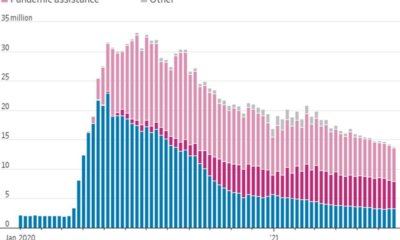Money
Technicity GTA 2023: How to grow a great city

A pivotal session at last week’s Technicity GTA conference explored the role technology plays when it comes to planning, maintaining and growing great cities. Moderated by David Stoehr, enterprise account executive with Google Cloud Canada, the bulk of the discussion revolved around the many challenges that exist in getting to the point where greatness is ultimately created.
City modernization and urbanization, event organizers stated in the conference guide, “result primarily from technological advancements. The importance to improve technological infrastructure with municipalities owning or managing 60 per cent of city infrastructure, helps to attract higher human capital needed to support systems for future development.”
It is a noble goal, but as panelists Grant Cowan, manager of IT for the Town of Innisfil, Cyrus Tehrani, chief digital officer and director of innovation with the City of Hamilton and Marco Palermo, deputy chief technology officer (CTO) of technology standardization delivery with the City of Toronto, not an easy one to achieve.
“The big problem we face is just the sheer size of the applications and solutions that have to be implemented and how to deliver them in a really effective way,” said Palermo.
Cowan added that it comes down to delivering services that are easy and seamless to use. Creating a positive customer experience, he said, is an important component.
That customer experience cannot simply be based on delivering a positive digital experience, for as Stoehr pointed out, a “digital divide” exists in all municipalities and it is an issue that must be addressed.
It is also a complicated matter, said Tehrani, because of a number of factors. Solving the issue involves far more than providing Wi-Fi connectivity in a bus station or a municipal park. Having the connectivity is one thing, but for those “marginalized within our community, will they have access to a device and the skills to use that device?”
“You want to ensure that your services are offered and available for everybody,” said Palermo, adding that a key piece of legislation is the city’s Digital Infrastructure Strategic Framework, which provides “base principles for ensuring equity and diversity within any technology implementation.”
The framework notes that the “benefits of digitization have not been equally distributed and particular communities continue to experience disproportionate barriers to access and participation which has led to a digital divide.
“Digital equity requires an understanding of barriers (such as algorithmic biases) facing Indigenous, Black and equity-deserving groups, including those with accessibility needs, as well as strategies to ensure that those groups are able to trust, participate and fully leverage the benefits of online digital services and technology.”
The fostering of the so-called great city can not be done alone, but jointly, with the private sector and post-secondary institutions. To that end, panelists were asked about the importance of working with other sectors.
“When it comes to the innovation ecosystem, it’s about finding those opportunities that work, that you can maybe sometimes try things, either on a smaller scale pilot, or get your feet wet without exposing or taking on a huge chunk of risk,” said Tehrani.
Palermo added that “we have engaged with different business partners, vendors and universities to advance a number of pilots.”
Stoehr then asked a key question: How do you drive change in such a risk-averse environment?
While Cowan replied by saying the key lies in creating a solid business case that mitigates any risks, and if they arise, are manageable, Palermo said it comes down to one word – deliver.
“I have been with the city for 19 years, and I am well versed in how it operates. But I can tell you this: deliver, just deliver good results and demonstrate to the leadership that sometimes, you must rip the band aid off.”
In other words, act quickly, which is something, he said, happened during the pandemic. ““What better time did we all have in the municipal space, certainly in IT, to finally rip that band aid off and say, ‘we need stuff urgently, we need to deliver to our residents, because our doors aren’t open at the moment, and so we’re going to show you what we’re really capable of.’
“And that’s exactly what we did at the city. And I can tell you, just within my team alone, we delivered over 140 solutions within a year and a half. The pandemic helped us really do that.”
Such digitization can be viewed as a success, said Stoehr, but he then asked the panel, on the flip side of that, what are the business risks of a municipality not modernizing?
The implications, from an economic perspective, will be dire, said Cowan. “If you are not modernizing at some point, that is going to start affecting your economic development as well. Businesses are going to (locate) elsewhere because they have these modern tools and services available.”
Palermo, meanwhile, said, “the real business risk of not modernizing is being rendered useless, and that is a scary thought, but I don’t think we would ever get there. Certainly within our city, and I could easily say the same for Hamilton, Innisfil and every other municipality across Canada, we’re really trying to push that envelope.”
Money
Where Tech Talent Goes To Thrive

here is a worldwide shortage of digital skills. In a world increasingly reliant on technology, demand for technological skillsets is rising by as much as 50%. Meanwhile, nearly three-quarters of today’s workers don’t feel equipped to learn the digital skills needed by businesses.
The most acute shortage is in advanced skills like programming, especially for new technologies like AI and blockchain.
This demand gives skilled tech workers, entrepreneurs, and leaders the pick of where to base themselves. As cities and nations compete to attract tech talent, what makes these prized individuals choose one place over another?.
Initial Attraction
In a survey of ‘tech migrants’, Boston Consulting Group identified a mixture of short-, medium-, and long-term levers businesses and cities could use to attract talent.
The initial attraction is often brute economics: higher pay and lower taxes. That’s certainly what brings people to Dubai, says Vladimir Vrzhovski, Tech and Digital Lead at Mercer: “Dubai pays about 30% higher than most of the mature tech hubs around Europe and Asia.” It also has a lower cost of living, especially when its 0% income tax is taken into account.
Businesses operating in the city’s free zones – like the tech-focused Dubai Internet City (DIC) and Dubai International Finance Centre (DIFC) Innovation Hub – also benefit from 0% corporation tax. BCG credits the incentive with bringing big names like Amazon, Google, and Oracle to the emirate.
It is an echo of London’s rise to tech prominence, offering tax relief on tech investments via its Seed Enterprise Investment Scheme (SEIS) to funnel the city’s vast pools of finance towards digital businesses.
The presence of blue-chip names affords another major draw for tech talent: opportunities.
Money
Adding exercise into treatment may reduce substance use, study shows

One key to fighting addiction may be exercise, according to a new study.
Researchers undertook a review of the existing literature around physical activity and its relationship to substance use, and they found that regular exercise was associated with lowered use in about 75% of the studies investigating that question, according to the analysis.
The review, published Wednesday in the journal PLOS ONE, looked at 43 studies with more than 3,000 total participants. In addition to a reduction or cessation in substance use, the studies also found improved markers of physical health and decreased depressive symptoms, the study said.
“People think that during treatment people should only do psychotherapeutic treatments … but that’s not what we’ve seen in our study,” said lead study author Florence Piché, a doctoral student and researcher at Université de Montréal in Canada. “It’s very beneficial to do physical activity in addition to the treatments.”
There are limitations to the findings. The review found that most of the studies the researchers examined had a high risk of bias, meaning more research is needed to confirm their findings, said Dr. Aaron Kandola, research fellow at Medical Research Council Unit for Lifelong Health and Ageing at University College London.
The studies were also not directly comparable enough to build a comprehensive and generalizable understanding of the relationship, Kandola said in an email. Kandola was not part of the research.
However, the findings were still significant and useful, he added.
“Substance use disorders are a major public health problem lacking low-cost, evidence-based solutions,” he said, adding that substance use disorders are worsening in many high-income countries — including the United States.
Finding more accessible solutions to this disorder is especially important because it often occurs with other mental health problems such as depression and anxiety, which disproportionately affect people with fewer socioeconomic resources and areas with higher deprivation, he said.
Physical activity may be a useful and accessible part of a treatment plan for substance use disorder, said Dr. Mark Smith, professor of psychology at Davidson College in North Carolina. Smith was not part of the research.
“I think there’s now a sufficient amount of data to indicate that various forms of physical activity and exercise are generally effective at reducing substance use in individuals seeking treatment,” he said.
What exercise does
Most people can benefit from engaging in physical activity, Kandola said.
One benefit the studies found is improvements in physical health such as cardiovascular endurance or muscle strength, Smith said. And although that may not be the primary goal of the research, he said this finding is important because it shows the physical activity is doing its job to promote physical health.
Money
Blood sugar drug tirzepatide also leads to substantial weight loss in diabetes patients, Eli Lilly says

There’s more evidence that the injectable drug tirzepatide helps people with diabetes lose weight as well as control their blood sugar, according to the drug’s manufacturer, Eli Lilly and Company.
In a new study, more than 900 adults with obesity and diabetes took the drug for a year and five months, and those on the highest dose lost an average of 34 pounds, or nearly 16% of their starting weight. It also helped people reduce their blood sugar, the company said in a news release. The data has not yet been peer-reviewed or published in a medical journal.
“We have not hit 15% in any other phase three trial for weight management in this type two diabetes population,” said Dr. Nadia Ahmad, an associate vice president at Eli Lilly and medical director of obesity clinical development for the company.
Ahmad said the company was pleased with these results, given how hard it is for people with type 2 diabetes to lose weight.
Tirzepatide is currently sold as Mounjaro and approved to help people with type 2 diabetes control their blood sugar.
Lilly says it will use the new study, along with results from an earlier study of weight loss in people without diabetes, to ask the US Food and Drug Administration to fast-track approval for tirzepatide purely for weight loss, which would make it a direct competitor to the blockbuster obesity drug Wegovy.
Plenty of people aren’t waiting for the FDA’s nod.
“I am aware of and I’ve heard, you know, it being sort of used off label for weight loss and individuals who do not have diabetes,” said Dr. Kimberly Gudzune, medical director of the American Board of Obesity Medicine. Gudzune was not involved in the tirzepatide study.
Gudzune points out that once a drug is FDA approved it can be prescribed for any reason a doctor sees as medically necessary.
Tirzepatide, along with several similar types of drugs taken for diabetes, went into shortage last year as success stories posted on social media fueled runaway demand for their weight loss benefits. The shortages made the medications difficult for patients with diabetes to get.
Tirzepatide works by mimicking the action of two different gut hormones. When blood sugar rises after eating, the drug stimulates the body to produce more insulin, which lowers blood sugar. It also slows down the movement of food from the stomach, making people feel fuller for longer. In clinical trials, people who took tirzepatide experienced more nausea, vomiting and diarrhea compared with those who took a placebo injection.
Semaglutide, manufactured by Novo Nordisk, has also been approved as a weight loss medication for overweight adults with at least one associated health problem since 2021. When prescribed for weight loss, it is sold under the brand name Wegovy. When prescribed for diabetes, the injection is sold under the brand name Ozempic.
High demand, coupled with manufacturing problems, threw Wegovy into shortage for much of the last year. That shortage then rippled into shortages for diabetes patients as doctors began prescribing other diabetes medications off-label for weight loss.
There has already been a lot of buzz about tirzepatide’s potential as an obesity medication. In a clinical trial published in the New England Journal of Medicine last year, people who were overweight or obese, but did not have diabetes, lost an average of 52 pounds on the highest dose of the drug, or more than 20% of their starting weight.
“In the last year has been really exciting just to have more tools in the toolbox, so to speak. And tools that, you know, we’re seeing really achieving outcomes that patients for the longest time have been hoping to achieve,” Gudzune said.
If those results hold up in the real world, that would make it the most potent of the injectable weight loss medications.
Indeed, this week Lilly aims to begin a study that will test Mounjaro against Wegovy head-to-head in 700 participants at 61 sites in the United States and Canada, according to clinicaltrials.gov. The study will conclude in February 2025.
-

 Business3 years ago
Business3 years agoHyundai Leads Industry in U.S. News & World Report 2023 Best Cars for the Money Awards
-

 Innovation2 years ago
Innovation2 years agoJay-S ventures into the urban genre with “Bailar en la Playa” his latest production
-

 Business3 years ago
Business3 years agoThree Questions Small Business Owners Should Ask In Creating A Workplace Culture – Forbes
-

 Business3 years ago
Business3 years agoA Fintech Makes It Easy For Small Businesses To Offer 401(k) Retirement Benefits – Forbes
-

 Business3 years ago
Business3 years agoBritain’s Small Businesses See Better Times Ahead But Is Their Optimism Justified? – Forbes
-

 Money3 years ago
Money3 years agoCharlie Crist leads Democratic gubernatorial field again in money chase – Florida Politics
-

 Money3 years ago
Money3 years agoTesting New Tools for Horizon Worlds Creators To Earn Money
-

 Business3 years ago
Business3 years agoSmall Business Labor Shortage – Forbes
